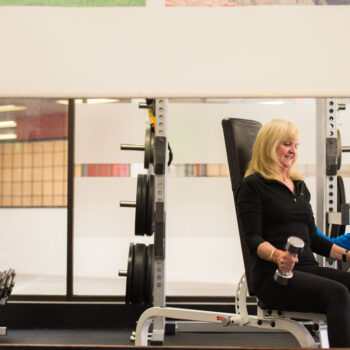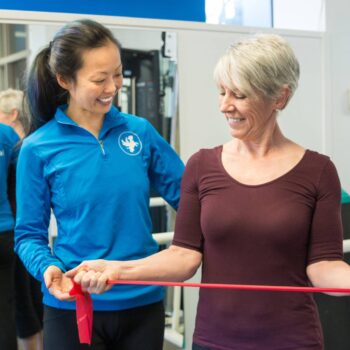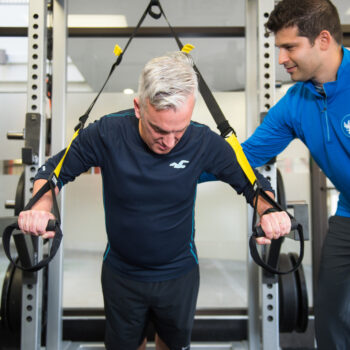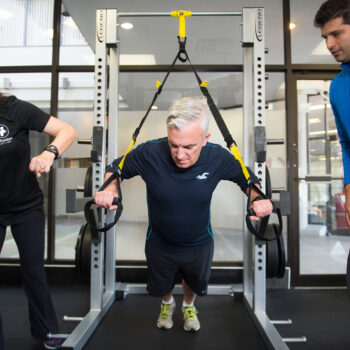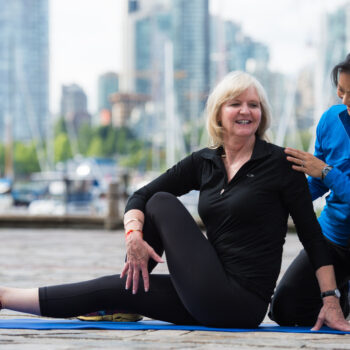In this article, we will dive into what a herniated disc is and what exercises can help improve your flexibility as well as strengthen your lower back, spine,and neck.
Unfortunately, you’ve probably heard someone – perhaps you– utter the words: “Oh my back!”
Sounds like the start of a muscle relaxant commercial, doesn’t it?
Or maybe you’ve uttered those words yourself in the past (we hope not)! Back issues seem to be an inevitable aging thing that plague us or someone we know once we start creeping towards middle age.
But is it inevitable? We’d like to think it isn’t, but for those of us that *have* experienced something like a disc herniation, we break down what has happened, why it might have happened, ways to prevent it and exercises you can do to help with your recovery.
What is a Disc Herniation?
Between each of the vertebrae in your spine, there is a shock absorbing “pad” called an intervertebral disc (3).
The purpose of these discs is to act as a shock absorber and protect the spine from daily activities, like walking, running, jumping, etc. Each disc has two parts: a soft, gel-like inner ring (known as the nucleus pulposus), and a tough fibrous outer ring (known as the annulus) (4).
A lot of university textbooks liken this ring to a “jelly donut” – when your outer ring is injured or the outer wall weakens, the inner ring might protrude out. When this happens, this is what is referred to as a herniated disc (4). The rupturing of the disc becomes problematic when the protrusion presses on, and irritates the surrounding nerves, which is when your body says “You need to stop!! Something is very wrong.”
Symptoms of a Herniated Disc
Individuals commonly report feelings of numbness or tingling in a limb or hand / foot. Sometimes they will find that that limb feels weak, for example, if it’s a herniation in the cervical area, grip strength may be noticeably less, or in the lumbar region, they stumble or misstep. Pain isn’t always felt directly in the lower back area. Patients might notice pain in the gluteal area, down the leg and into the foot (4).
Not all disc herniations produce symptoms, and can only be seen in scans / images.
What’s a Slipped Disc? Is it the Same Thing?
Terms like slipped disc, or ruptured disc, or bulging disc are interchangeable with herniated disc. Though with some terms like slipped disc, it conjures images that your intervertebral disc is a hockey puck that’s just moved a little out of place, and just needs to be popped back into place …isn’t 100% accurate. Either way, they are all the same thing.
How Does a Disc Herniation Happen?
A herniated disc often occurs with movements such as lifting, pulling, bending, twisting. We commonly hear stories of a client experiencing a herniation while lifting boxes or pulling a heavy object, but many people might experience a herniation bending down to pick up a stray sock. Poor posture and ergonomics may also contribute to the likelihood of having a herniation occur.
Herniations tend to occur more in the lumbar region of the back (lower back) since many people tend to twist and bend from there. Remember the old saying “lift with the legs, not with the back?” …that’s where this comes from. It is also possible in the cervical spine (neck area) to experience a herniation. Lumbar disc herniations are more prevalent than cervical spine (approximately 15 times more frequently). While thoracic spine herniations are possible, they only account for approximately 1 – 2% of all cases.
Do I Need Surgery?
There are certain situations where your GP may recommend surgery for your herniation. Situations such as consistent/ongoing pain that negatively impacts your activities of daily living, loss of bladder/bowel control or inability to stand and walk, maybe qualifiers for an invasive procedure (3).
Most of the time, people are able to catch their pain at a stage that is minor enough to not warrant surgery, yet requires enough of your attention to modify or change behaviours to rehabilitate and prevent future occurrences.
Definitely talk to your doctor and explore all the options available to you.
People at Risk of Disc Herniations
Individuals may be at increased risk for a herniated disc if they often turn or twist their backs while lifting objects, if they use tobacco, or have poor posture (4). Therapists often encounter clients with these issues if they are overweight, may have weak muscles (especially around the core), and/or a sedentary lifestyle. Herniated discs are most common in early to middle-aged adults (4).
Should I just lay in bed and wait it out? How can exercise help?
For some people, laying in bed is the only thing they feel they can do in that moment and any movement might cause too much pain. In this case, we strongly recommend you see your GP or physio as soon as you’re able.
If there are movements that you *can* do that feel better than others (ex: if you find the fetal position feels better than an extended position or vice versa), then place yourself in these postures when possible, while feeling immobilized. As soon as you can do small movements that don’t cause issues, take your time to increase those movements and get to your health care professional’s office (4).
If you have been diagnosed with a disc herniation and your GP or physio has recommended that you “get moving” then *specific types* exercises will be helpful (2). Jumping on your favourite rowing machine, getting back to those deadlifts or starting your daily burpee challenge might not be such a great idea right now. More than likely, your body will tell you this then second you slip on your runners. But just in case…we thought we’d tell you.
Exercising is an effective way to strengthen and stabilize your low back muscles and prevent further injury and pain (1). It also gives you strong muscles that work when you need them to, supports your body weight and bones, and takes unnecessary pressure off your spine.
Top Exercises to do if you Have a Herniated Disc
First off, if you are reading this, hopefully you’re just doing some research on the topic and don’t have one, but if you do, we’re assuming you’ve seen your GP and physiotherapist to diagnose the issue and help reduce inflammation, start the healing process etc. If not, here’s our disclaimer that the following info isn’t intended to be medical advice and we recommend you start there.
These are the types of activities/motions we Kinesiologists may incorporate with clients that have been sent to us, with a diagnosis of a disc herniation. Keep in mind everyone’s program is unique and we may or may not do all of these exercises with them. With all movements, breathe through them, and there should be NO PAIN.
- Spinal Decompression
-
- Find something you can hang from, like the top of a doorframe
- Reach overhead and hold the top of the frame with an overhand grip
- Allow yourself to “hang” for up to 30 seconds. Depending on your grip strength and the surface you have to hang from, we don’t recommend a full hang. Gently bend your knees a little to feel your spine decompress a bit
- Repeat 2-3 times
- This exercise will take pressure off your discs by creating space between your vertebrae
- Prone extension (half, or baby cobra pose)
-
- Lay on your stomach
- Place your forearms on the floor next to your body and elbows bent
- Slowly prop yourself up on your elbows, keeping your hips in contact with the floor Imagine coming off the floor only a couple inches to start
- Breathe and listen to your body
- Hold the upwards position for 10-15 seconds before returning to your starting position
- Repeat 3 – 5 times, gradually increasing the time you hold the upward position until you reach 30 seconds
- As you get stronger and your body can tolerate this position, you can slowly increase the range of motion so your body is more upright, arms are a bit straighter, and you’re moving into a “full cobra” position
Nicole and Gillian break down techniques and cues to look out for when performing the Cobra in this video HERE
- Cat-cow (1)
-
- Begin on your hands and knees
- Inhale, let your bellybutton/midsection “drop” towards the floor, lift your tailbone and gently look up towards the ceiling (if you have a cervical herniation, do not do this exercise).
- Slowly exhale, rounding your spine, moving your upper back towards the ceiling, while using your hands to press into the floor, tuck in your tailbone, let your head and neck relax to look at your knees
- Do 2-3 sets of 10 reps
- This movement will open the intervertebral disc space, helping to relieve pressure on the herniated disc while improving the mobility of the spine.
Nicole and Gillian break down techniques and cues to look out for when performing the full Cat-cow in this video HERE.
Top 5 exercises or movements to AVOID
Dr. Seth Neubardt, a board-certified spine surgeon, recommends avoiding any high-impact exercises while your herniated disc is healing (5). Exercises like running, jumping, powerlifting, or anything that involves sudden sharp movements, can greatly increase your pain and slow down healing. It may even cause lifelong problems.
We’re not saying you can’t return to them over time, just not right now.
Disc / Back Herniation prevention
There are only so many things we can control in life. What we can’t, we can’t. But if we can influence some factors, the top three recommendations for disc herniation preventions
- If your body is carrying extra weight around the midsection, that can put strain on your core muscles and lower back, which impacts your spine. Doctors will often recommend beginning a weight management / loss program to help decrease the load (4).
- If you are a smoker, it might be worth considering a smoking cessation program to facilitate the healing process of your intervertebral discs (4).
- Ensure you have a strong core – now this is a really big catch-all term, that some people think they get (“I can easily do 100 situps” or “my balance is great, I ski and cycle”) but it’s hard to say that someone has a strong core without assessing it (2).
- Ensure correct mechanics for life and in the gym (prehab) – connect with a kinesiologist to check how well your core is functioning and have a movement analysis to ensure your body moves efficiently and effectively, or learn better movement techniques, if you’re not sure.
Questions? Comments? We’re here to help!
References
- Bakhtiary, A. H., Safavi-Farokhi, Z., & Rezasoltani, A. (2005). Lumbar stabilizing exercises improve activities of daily living in patients with lumbar disc herniation. Journal of Back and Musculoskeletal Rehabilitation, 18(3-4), 55-60. doi:10.3233/bmr-2005-183-401
- Highsmith, J. M. (2019, July 16). Herniated Disc Exercises. Retrieved from https://www.spineuniverse.com/conditions/herniated-disc/exercise-herniated-discs
- Herniated disk. (2012). orthoinfo.aaos.org/en/diseases–conditions/herniated-disk/
- Herniated disk in the lower back. (2018) https://orthoinfo.aaos.org/en/diseases–conditions/herniated-disk-in-the-lower-back/
- Neubardt S [Dr. Neubardt and Dr. Stern – The Neuro-Ortho Team]. (2015). ?Exercise for non-surgical treatment of the cervical herniated disc [Video file]. youtu.be/3_nITrnF5vg
- Slipped disc: Overview. (2020). InformedHealth.org. Retrieved from https://www.ncbi.nlm.nih.gov/books/NBK279472/.


